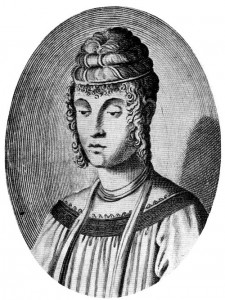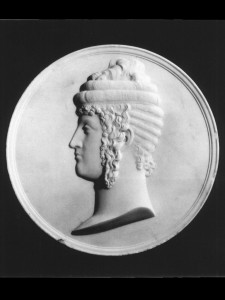- Cassandra Fedele
- Medal of Cassandra Fedele, Istituto Veneto di Scienze, Lettere ed Arti
By Juliana Ossa Martinez
Cassandra Fedele (1465-1558) Fedele was a renowned Italian scholar. Born in 1465, she was the daughter of Barbara Leoni and Angelo Fedele. Her father was learned in Greek and Latin, and was respected among the aristocracy.[1] He trained his daughter in Greek and Latin, and by the age of twelve she had reached fluency in these languages.[2] She was then sent to learn classical literature, philosophy, science, and dialectic under the tutorage of Gasparino Borro, a Servite friar.[3]
At the age of sixteen, she joined an active circle of scholars at the University of Padua alongside renowned humanists, such as Niccolo Tomei, Giovanni Aurelio Augurello, Bonifacio Bembo, Panfilo Sasso, Gianfrancesco Superchio and Girolamo Campagnola.[4] It is presumed that Fedele wrote a volume of Latin poems, which was never found.[5] She was greatly admired by Angelus Politanus, who wrote a letter to Lorenzo de Medici praising her for her excellence in Italian and Latin, as well as for her beauty.[6]
According to Mary Hays, “She embellished even theology by the graces of her style and manner; maintained theses with great reputation and gave public lectures at Padua.”[7] In 1487, Fedele became well known in Italy and abroad after delivering a speech in Latin in praise of the arts and sciences at her cousin’s graduation from the University of Padua. The speech was titled Oratio pro Bertucio Lamberto and was published three times in different cities: in Modena in 1487, in Venice in 1488, and in Nuremberg in 1489. With the publication of this speech, her reputation as a writer spread to Florence, Ferrara, Milan, Germany, and Hungary. [8] Sometime later, the philosopher Giorgio Valla invited her to present another public lecture, in which she praised the study of literature and addressed the importance of women’s advanced education. This speech was delivered before Agostino Barbarigo and the Venetian Senate.[9]
From 1487 to 1498 Fedele exchanged a total of 123 letters with important figures — King Ferdinand of Aragon, Isabella of Castile, Duchess Beatrice d’Este of Milan, Queen Beatrice d’Aragona of Hungary, Duchess Eleonora d’Aragona of Ferrara, Marchese Francesco Gonzaga of Mantua ,and King Louis XII of France. By the end of 1490, Fedele was the most renowned female humanist in Europe. Isabella of Castile attempted unsuccessfully to persuade Fedele to join her in the Spanish court.[10]
Fedele’s epistolary collection was titled Epistolae et orationes, and includes a speech she wrote in 1521 directed to Pope Leo X.[11] Her correspondence also includes letters she exchanged with Italian members of the intellectual circle of Lorenzo de Medici, like Giovanni Pico della Mirandola, Bartolomeo Scala, and his daughter Alessandra Scala.[12] The Epistolae et orationes “circulated widely in Italy but failed to find a readership north of the Alps” when published after her death in 1636.[13]
In 1499, at the age of thirty-four, Fedele married the Venetian physician Gian-Maria Mapelli . Little is known of their marriage, but evidence shows that they did not have children.[14] In 1515 Fedele and Mapelli sailed to Crete, where they lived for five years while Mapelli practiced medicine. In 1520, on their way back to their resettlement in Venice, Fedele and her husband lost all their belongings in a shipwreck.[15] This could explain the lack of evidence about Fedele’s intellectual activity after her marriage.[16]
Fedele was widowed that same year. Childless and in financial straits, she spent the following decades unsuccessfully looking for employment as a teacher.[17] In 1521, she wrote a letter to Pope Leo X asking for help, but it is said that he did not reply.[18] In 1547 she wrote to Pope Paul III ,who appointed her prioress of the orphanage of San Domenico di Castello in Venice. [19]
When Queen Bona Sforza of Poland visited Venice in 1556, Fedele was invited to give a public speech before the Venetian senate and Doge Francesco Venier to commemorate the arrival of the Queen.
Cassandra Fedele died two years later in 1558 at the age of ninety-three. Upon her death, she was honored with a public funeral at the church of San Domenico, where “her body was placed on a marble bier, her white hair bound with laurel.”[20]
[1] Stella Cantini, “Cassandra Fidele,” Mary Hays, Female Biography; or, Memoirs of Illustrious and Celebrated Women, of All Ages and Countries (1803) Chawton House Library Series: Women’s Memoirs, ed. Gina Luria Walker, Memoirs of Women Writers Part II (Pickering & Chatto: London, 2013), vol. 8, 332-33, editorial notes, 572-72, on 572, and Jennifer Haraguch, “Fedele Cassandra (1465?-1558).” Italian Women Writers, University of Chicago Library, 2003, accessed July 9, 2014, http://www.lib.uchicago.edu/efts/IWW/BIOS/A0015.html
[2] Diana Maury Robin, Anne R. Larsen, and Carole Levin, Encyclopedia of Women in the Renaissance: Italy, France, and England (Santa Barbara, CA: ABC-CLIO, 2007), 137, and Cantini, “Cassandra Fidele,” vol. 8, 332-33, editorial notes, 572-72, on 572.
[3] Haraguch, “Fedele Cassandra (1465?-1558).”
[4] Robin, Larsen and Levin, Encyclopedia of Women in the Renaissance, 137.
[5] Cantini, “Cassandra Fidele,” vol. 8, 330-31, editorial notes, 572-72, on 572.
[6] Mary Hays, “Cassandra Fidele,” Female Biography; or, Memoirs of Illustrious and Celebrated Women, of all Ages and Countries (6 volumes) (London: R. Phillips, 1803), vol. 6, 330-31 on 330, and Haraguch, “Fedele Cassandra (1465?-1558).”
[7] Hays, “Cassandra Fidele,” vol. 6, 330-31, on 330.
[8] Robin, Larsen and Levin, Encyclopedia of Women in the Renaissance, 137.
[9] Robin, Larsen and Levin, Encyclopedia of Women in the Renaissance, 137.
[10] Robin, Larsen and Levin, Encyclopedia of Women in the Renaissance, 138.
[11] Cantini, “Cassandra Fidele,” vol. 8, 330-31, editorial notes, 572-72, on 572, and Robin, Larsen and Levin, Encyclopedia of Women in the Renaissance, 137-38.
[12] Robin, Larsen and Levin, Encyclopedia of Women in the Renaissance, 137.
[13] Robin, Larsen and Levin, Encyclopedia of Women in the Renaissance, 137.
[14] Haraguch, “Fedele Cassandra (1465?-1558).” and Robin, Larsen and Levin, Encyclopedia of Women in the Renaissance, 138.
[15] Haraguch, “Fedele Cassandra (1465?-1558).” and Robin, Larsen and Levin, Encyclopedia of Women in the Renaissance, 138.
[16] Haraguch, “Fedele Cassandra (1465?-1558).”
[17] Robin, Larsen and Levin, Encyclopedia of Women in the Renaissance, 138.
[18] Haraguch, “Fedele Cassandra (1465?-1558).”
[19] Haraguch, “Fedele Cassandra (1465?-1558).” and Robin, Larsen and Levin, Encyclopedia of Women in the Renaissance, 138.
[20] Robin, Larsen and Levin, Encyclopedia of Women in the Renaissance, 138.
Bibliography:
Cantini, Stella. “Cassandra Fidele.” Mary Hays, Female Biography; or, Memoirs of Illustrious and Celebrated Women, of All Ages and Countries, 1803. Chawton House Library Series: Women’s Memoirs, ed. Gina Luria Walker, Memoirs of Women Writers Part II. Pickering & Chatto: London, 2013, vol. 8, 332-33, editorial notes, 572-72.
Haraguch, Jennifer. “Fedele Cassandra (1465?-1558).” Italian Women Writers, University of Chicago Library, 2003. Accessed July 9, 2014. http://www.lib.uchicago.edu/efts/IWW/BIOS/A0015.html
Hays, Mary. “Cassandra Fidele.” Female Biography; or, Memoirs of Illustrious and Celebrated Women, of all Ages and Countries (6 volumes). London: R. Phillips, 1803, vol. vol. 6, 330-31.
Robin, Larsen, and Levin. Encyclopedia of Women in the Renaissance: Italy, France, and England Santa Barbara, CA: ABC-CLIO, 2007.
Page citation:
Juliana Ossa. “Cassandra Fedele.” Project Continua (March 22, 2015): Vol. 1, (date accessed), http://www.projectcontinua.org/cassandra-fedele/
Tags: End of Renaissance, Europe, Poets, Reformation, Renaissance, Writers


